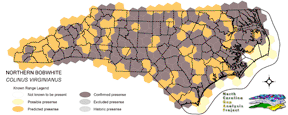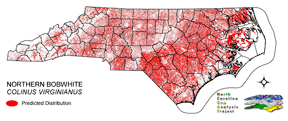
| Taxa: |
| Order: |
| Family: |
| Aves |
| Galliformes |
| Odontophoridae |
| NatureServe Global Rank: |
| NatureServe State (NC) Rank: |
| G5 |
| S5 |
| Federal Status: |
| NC State Status: |
| --- |
| --- |


| Land Unit |
| US Fish & Wildlife Service |
| US Forest Service |
| US National Park Service |
| US Department of Defense |
| NC State Parks |
| NC University System |
| NC Wildlife Res. Com. |
| NC Forest Service |
| NC Div. of Coastal Mgmt. |
| Local Governments |
| Non-Governmental Org. |
| Other Public Lands |
| Private Lands |
| GAP Status 1-2 |
| All Protected Lands |
| Statewide |
| Hectares |
| 8,325.99 |
| 23,001.30 |
| 60,426.90 |
| 3,673.71 |
| 5,088.42 |
| 4,381.38 |
| 27,116.19 |
| 4,821.87 |
| 57.33 |
| 1,122.12 |
| 3,178.08 |
| 3,417.84 |
| 4,764,934.17 |
| 27,766.20 |
| 142,594.50 |
| 4,909,545.30 |
| Acres |
| 20,573.97 |
| 56,837.44 |
| 149,318.09 |
| 9,077.93 |
| 12,573.76 |
| 10,826.62 |
| 67,005.55 |
| 12,191.91 |
| 141.67 |
| 2,772.82 |
| 7,853.21 |
| 8,445.66 |
| 11,774,406.46 |
| 68,888.57 |
| 352,635.42 |
| 12,132,025.09 |
| % of Dist. on |
| Prot. Lands |
| 5.8 % |
| 16.1 % |
| 42.3 % |
| 2.6 % |
| 3.6 % |
| 3.1 % |
| 18.3 % |
| 3.4 % |
| < 0.1 % |
| 2.1 % |
| 2.1 % |
| 1.9 % |
| < 0.1 % |
| 19.5 % |
| ----- |
| ----- |
| % of Dist. on |
| All Lands |
| 0.2 % |
| 0.5 % |
| 1.2 % |
| < 0.1 % |
| 0.1 % |
| < 0.1 % |
| 0.6 % |
| < 0.1 % |
| < 0.1 % |
| < 0.1 % |
| < 0.1 % |
| < 0.1 % |
| 97.1 % |
| 0.6 % |
| ----- |
| ----- |
|
Uncommon to common across the entire state (Potter et al. 1980). Population decreasing in the coastal area (Fussell 1994). A habitat generalist (Nicholson 1997), the Northern Bobwhite breeds in a variety of early successional stage habitats, such as exist in agricultural areas, open deciduous and mixed forests (Brennan 1999), overgrown fields, woodland edges (Fussell 1994), and gaps made in the forest by logging (Stupka 1963). In Tennessee, are most abundant in a mosaic of agricultural fields, wooded hedgerows, and fallow fields dominated by broom sedge (Nicholson 1997). Nesting sites can be found in woodlands or fields (Harrison 1975), usually within 15-20 m of an opening such as a field or road. The nest is located on ground that is partially covered with standing vegetation <45 cm tall (Brennan 1999) and placed in a tuft of dead or live grass with surrounding herbaceous plants covering it and often woven into an arch above it (Harrison 1975). NATURE SERVE GLOBAL HABITAT COMMENTS: Brushy fields, grasslands (primarily long grass), cultivated lands, and open woodland, in both humid and semiarid situations (AOU 1983). Nests on the ground among concealing vegetation (e.g., brush or long grass). |
| Code | Name | Description | NC Natural Heritage Program Equivalent |
| 97 | Mesic Longleaf Pine | Longleaf pine woodlands without a major scrub oak component. Slash or loblolly pines may be present as well. | Mesic Pine Flatwoods |
| 42 | Xeric Longleaf Pine | Sandhills including a range of longleaf pine density from predominantly wiregrass, scrub oak dominated to true longleaf pine woodland. This does not include mesic or saturated flatwood types. | Xeric Sandhill Scrub, Pine/Scrub Oak Sandhill, Coastal Fringe Sandhill |
| 226 | Piedmont Xeric Woodlands | Generally post and blackjack oak dominated woodlands. White ash and pignut hickory can be found in combination with Eastern red cedar on glades. | Xeric Hardpan Forest |
| 20 | Coniferous Regeneration | Regenerating pine stands. Predominantly loblolly pine, but slash and longleaf stands occur as well. | No equivalent |
| 36 | Successional Deciduous Forests | Regenerating deciduous trees with a shrub stature. Commonly dominated by sweetgum, tulip poplars and maples. | No equivalent |
| 180 | Agricultural Crop Fields | Farm fields used for row crops. | No equivalent |
| 205 | Agricultural Pasture/Hay and Natural Herbaceous | Farm fields used for pasture grass or hay production, as well as old fields dominated by native and exotic grasses. | No equivalent |
| 202 | Residential Urban | Includes vegetation interspersed in residential areas. Includes lawns, mixed species woodlots, and horticultural shrubs. Vegetation accounts for between 20 - 70% of the cover. | No equivalent |
|
Taylor, J. S., and F. S. Guthery. 1994. Daily movements of northern bobwhite broods in southern Texas. Wilson Bull. 106:148-150.
Errington, P. L., and F. N. Hammerstrom, Jr. The northern bob-white's winter territory. Iowa State Univ. Press. 141 pp. Stoddard, H. 1942. The bobwhite quail:its habits, preservation and increase. New York. 559 pp. Ehrlich, P.R., D.S. Dobkin, and D. Wheye. 1992. Birds in jeopardy:the imperiled and extinct birds of the United States and Canada, including Hawaii and Puerto Rico. Stanford University Press, Stanford, California. 259 pp. Coody, C. J. 1991. An improved census technique of the northern bobwhite (COLINUS VIRGINIANUS) using recorded calls of the female. M. S. thesis, Univ. of Arkansas. 46 pp. [Issued also as Arkansas Cooperative Fish and Wildlife Research Unit Publication No. Fussell, J.O. III. 1994. A birderís guide to coastal North Carolina. Chapel Hill and London: The University of North Carolina Press. Nicholson CP. 1997. Atlas of the breeding birds of Tennessee. Knoxville: University of Tennessee Press. Brennen, L.A. 1999. In Poole A, Gill F, eds. The birds of North America. No. 397. Stupka A 1963. Notes on the birds of the Great Smoky Mountains National Park. Knoxville: The University of Tennessee Press. Rosene, W. 1969. The bobwhite quail; its life and management. Sun Press. 418 pp. [reissued by Morris Communications in 1984]. Tomlinson, R. E. 1972. Review of literature on the endangered masked bobwhite. U. S. Fish & Wildl. Serv. Res. Publ. 108:1-28. Johnsgard, P. A. 1973. Grouse and quail of North America. U. of Nebraska, Lincoln. 553 pp. Harrison, H.H. 1975. A field guide to bird's nests in the U.S. east of the Mississippi River. Houghton Mifflin Company, Boston, Massachusetts. 257 p. Harrison, C. 1978. A field guide to the nests, eggs and nestlings of North American birds. Collins, Cleveland, Ohio. Stoddard, H. 1978. The bobwhite quail:its habits, preservation and increase. New York. Scribner's. 559 pp. Potter, E. F., J. F. Parnell, and R. P. Teulings. 1980. Birds of the Carolinas. Univ. North Carolina Press, Chapel Hill. 408 pp. Terres, J.K. 1980. The Audubon Society encyclopedia of North American birds. Alfred A. Knopf, New York. American Ornithologists' Union (AOU), Committee on Classification and Nomenclature. 1983. Check-list of North American Birds. Sixth Edition. American Ornithologists' Union, Allen Press, Inc., Lawrence, Kansas. Raffaele, H.A. 1983. A guide to the birds of Puerto Rico and the Virgin Islands. Fondo Educativo Interamericano, San Juan, Puerto Rico. 255 pp. Lehmann, V. W. 1984. Bobwhites in the Rio Grande plain of Texas. Texas A & M Univ. Press. xv + 371 pp. Roseberry, J. L., and W. D. Klimstra. 1984. Population ecology of the bobwhite. Southern Illinois Univ. Press, Carbondale. xvii + 259 pp. Scott, M.D. and G. Servheen. 1985. Wildlife research:caribou ecology. Idaho Dept. Fish and Game. 137 pp. Johnsgard, P. A. 1988. The quails, partridges, and francolins of the world. Oxford Univ. Press, New York. 264 pp. Brennan, L. A. 1991. How can we reverse the northern bobwhite population decline? Wildl. Soc. Bull. 19:544-555. Rosene, W. 1969. The bobwhite quail. New Brunswick. 418 pp. Droege, S., and J.R. Sauer. 1990. North American Breeding Bird Survey, annual summary, 1989. U.S. Fish and Wildlife Service, Biological Report 90(8). 22 pp. Janvrin, J. A., E. P. Wiggers, and T. V. Dailey. 1991. Evaluation of drive counts for estimating northern bobwhite densities. Wildl. Soc. Bull. 19:XXX-481. |
For more information please contact them at:
NC-GAP Analysis Project
Dept. of Zoology, NCSU
Campus Box 7617
Raleigh, NC 27695-7617
(919) 513-2853
www.basic.ncsu.edu/ncgap